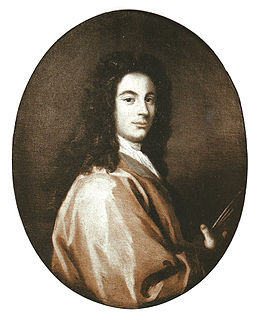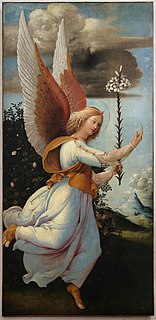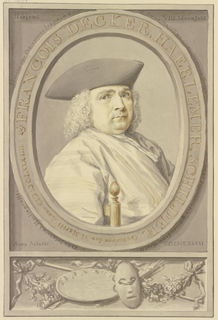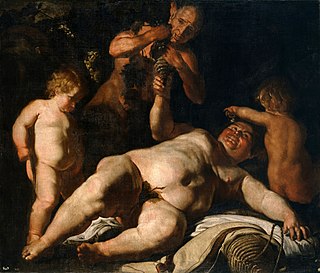
Orlando Flacco or Fiacco (fl. 1560) was an Italian artist.

Orlando Flacco or Fiacco (fl. 1560) was an Italian artist.
Flacco, a native of Verona, was a painter who flourished about 1560. He a pupil of Francesco Torbido, known as Il Moro. His style much resembles that of Badile. Vasari praises his portraits, and Lanzi says that his forms resemble those of Caravaggio. He painted a Crucifixion and an Ecce Homo in the church of Santi Nazaro e Celso in Verona. [1]
Flacco is an Italian surname. Notable people with the surname include:

Antonio Balestra was an Italian painter of the Rococo period.

Bernardino India (1528–1590) was an Italian painter of the late Renaissance, born and mainly active in Verona. He is said to have trained with Domenico Riccio. He collaborated with Michele Sanmicheli in the Canossa palace and Pellegrini chapel in San Bernardino of Verona. He collaborated with Felice Brusasorci, Domenico's son in frescoes at Palazzo Fiorio Della Seta. He decorated Palladian villas such as Villa Pojana, Villa Foscari where Giovanni Battista Zelotti also worked, and the Palazzo Thiene in Vicenza. Orlando Flacco completed his most extensive work for the Sala Maggior di Consiglio in Verona.

Andrea Boscoli was an Italian painter of the Renaissance.
Giovanni Badile was an Italian painter active in Verona.
Antonio Catalano, also called Catalani or il Siciliano, (1560–1630) was an Italian painter of the late-Renaissance and early-Baroque periods.

Marco Antonio Bassetti (1586–1630) was an Italian painter.

Luigi Benfatto known as Alvise dal Friso (1551–1611) was an Italian painter of the late-Renaissance period. He was born at Verona, was the nephew and pupil of Paolo Veronese. He painted Glory of the saint for the church of St. Nicholas and pictures of St. Marta for the Church of Santa Marta al Collegio Romano. He is also called Luigi Alvise dal Friso. A pupil of his was Maffeo Verona.
John Butts was an Irish landscape painter.
Michelangelo Aliprandi (1527–1595) was an Italian painter from Verona, who also painted a fresco at the Miniscalchi Palace there. He who flourished from about 1560 to 1582.

Battista del Moro was an Italian painter of the Renaissance period active in his native Verona, as well as in Mantua and Venice.
Marco Angolo del Moro,, the son and pupil and assistant of Battista, flourished in the latter half of the 16th century at Venice and Verona. He assisted his father in his wall decorations at Murano. He also practised the art of engraving with considerable success.
Jacopo Avanzo of Verona, has long been confused with Jacopo degli Avanzi of Bologna; but the remains of an inscription in the Cappella San Giorgio point to Verona as the birthplace of Avanzo. He painted decorations, in conjunction with Altichiero da Zevio, in the Cappella San Felice and the Cappella San Giorgio in the church of Sant' Antonio at Padua, in 1377. It appears that the principal frescoes in the Cappella San Felice were the work of Altichiero; and of those in the Cappella San Giorgio, which were recovered from oblivion in 1837 by Dr. E. Förster, the part to be assigned to Altichiero has given rise to much dispute; but it is thought by some authorities that Avanzo executed the principal portion. The frescoes represent the earlier part of the 'History of our Lord,' the 'Coronation of the Virgin,' the 'Crucifixion,' and 'Legends of St. George, St. Catharine, and St. Lucy.' They prove the painter to have been an artist of no common genius, and Kugler, in his description of them, speaks of his art as being above that of his contemporaries. Avanzo also painted two triumphal processions in a public hall of Verona, which have long since perished. He died about the end of the 14th century.

Fra Girolamo Bonsignori, was an Italian artist.
Lorenzo Costa the Younger (1537–1583) was an Italian painter of the Renaissance period, active in his native city of Mantua.
Francesco dai Libri, the elder, born at Verona in 1452, was the son of Stefano dai Libri, an illuminator of books. He was the father of Girolamo dai Libri, and is known as an illuminator of choir books for the churches of his native city.

Frans Decker, was an 18th-century painter from the Northern Netherlands.
Domenico Fossati was born at Venice in 1743, and studied painting at the Accademia di Belle Arti of that city. He distinguished himself as a painter of architecture and a decorator, and his works are to be met with in the theatres and palaces of Venice, Padua, Vicenza, Verona, Udine, Monza, and Gratz, and in the Scala at Milan. He died at Venice in 1785.

Cesare Fracanzano (1605-1651), a Neapolitan painter who flourished in the 17th century, was a pupil of Spagnoletto. Born in Bisceglie, in Apulia by Alessandro, a nobleman originally from Verona and a mannerist painter. His pictorial style was based on Ribera, but also on Tintoretto, the Carracci brothers and Guido Reni. After long years of artistic preparation and work in Naples, in 1626 he returned to Apulia, to Barletta where he married Beatrice Covelli. He worked a lot in the Apulian town in churches and noble palaces. He moved from his hometown only to carry out work commitments in Naples, Rome and other places in Apulia. There is in the Museo del Prado (Madrid) a picture by him, representing Two Wrestlers. His son, Michelangelo Fracanzano, who was also a painter, died in France about 1685. His brother Francesco was also a painter.
Anselmo Canera, or Canneri, was an Italian painter of the late Renaissance, born and mainly active in Verona. Little is known of his biography. He is said to have trained with Giovanni Francesco Caroto. He painted in fresco in some of the Palladian construction in and around Verona, including Palazzo Thiene and those of Villa Pojana in Pojana Maggiore. During 1550-1560, he collaborated in such fresco work with Bernardino India. He worked with the young Paolo Veronese at the Villa Soranzo near Treviso in 1552, and subsequently is recorded painting at Castelfranco, Vicenza, and Verona. In 1584, his canvas of the Insult to the Pharaoh formed part of a trio of canvases, the others by Felice Brusasorzi and Paolo Farinati depicting scenes from the life of Moses in the Palazzo Ridolfi.
| Wikimedia Commons has media related to Orlando Flacco . |